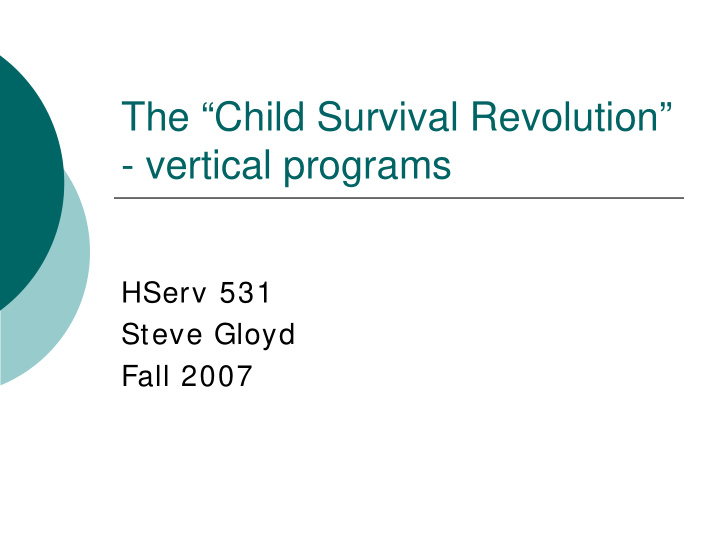



The “Child Survival Revolution” - vertical programs HServ 531 Steve Gloyd Fall 2007
Synonyms Selective Primary Health Care (Walsh, Warren) Child Survival (USAID) GOBI-FFF (UNICEF) Growth monitoring Oral Rehydration Therapy Breast Feeding Immunizations Family Planning Female Literacy Food
Selective Primary Health Care Rationale PHC is great, but can’t afford it PHC requires political will that isn’t there PHC need immense organizational support I deology of Cost-effectiveness Establish priorities (Can’t do everything at once) Quick fix (short term goals) Trust in power of technology to address social & economical problems
Selective Primary Health Care � Components of SPHC (Walsh, Warren Model) � Flexibility (fixed or mobile units) � Limited interventions of “proven efficacy” � Oral rehydration therapy � Immunizations � Breast feeding � Local disease control (malaria, schistosomiasis, tuberculosis)
Justification for ‘selective’ interventions - 1986
Child Survival Principles Prioritize condition of most importance 1. Focus on kids Assess feasibility of interventions 2. Consider intervention of “proven efficacy” ORT/ Immunizations “Cost-effectiveness” Postpone interventions that are either 3. too expensive – Water/ sanitation unproven efficacy-schisto/ trypanomoiasis Organizationally, consider mobile teams, campaigns, 4. fixed units Gradual, cost-effective way to achieve PHC 5.
Primary Health Care Framework MCH Integrated Programs Support Managers and providers Referral systems Facility maintenance Health Center Lab, pharmacy systems Health Post Health Post Health Post CHW CHW CHW CHW TBA TBA
Child Survival Projects Integrated MCH programs in MOH Support CS •Vaccination Campaigns •Mobile Units •Cold Chain Immunizations CHW ORT CHW Health Education
Questions regarding child survival programs Do Child Survival interventions reduce overall 1. mortality in children under 5 years old? Do they strengthen efforts to establish primary 2. health care? Do they address felt needs? 3. De they facilitate community development? 4. Do they encourage reallocation of resources? 5.
Evolution of disease-specific ( vertical) approaches – donor driven � Family Planning (pre-Child Survival) � ORT-Immunizations (Child Survival,Gobi) - 1979 � Vitamin A -1983 � Maternal mortality, TBAs - 1986 � ALRI (Acute lower respiratory diseases) - 1986 � HIV-AIDS prevention and care - 1988 � Polio eradication ~ 1990 � Malaria - Integrated management of childhood illnesses (IMCI) - 1990, 2000 � Tuberculosis ~ 1995
Underlying reasons for child survival Results (rapid) 1. Efficiency 2. Application of new, appropriate 3. technologies
Underlying reasons for child survival (1) Results 1. Donor agencies tired of big programs with • little chance of measurable impact Need for short-term results (3-5 years) • Funding cycle, tenure of administrations is • also short Single outcome, measurable results (EPI vs • water)
Underlying reasons for child survival (2) 2. Efficiency Change organizational structure to achieve measurable goals ( e.g. immunization programs often work better outside of the usual MOH structure; cold chain, distribution, supervision can be more efficient if created for specific purposes) Thus, there is a tendency for: Independent organizational structure (usually within MOH) � Singular focus � Mobile teams/ campaigns � CHWs (esp for ORT, mobilization for Immuniz) � Central Planning (already have interventions in mind) � LESS NEED FOR complex organization of PHC (e.g., � training of mid-level health providers, distribution system, referral network, link with hospitals)
Underlying reasons for child survival (3) 3. Application of new, appropriate technologies faith in capacity of vaccines, ORT � less faith in organizational structure to cope � with diseases magic bullet ideology �
Ideological shifts Public responsibility Individual responsibility Government health services Government bureaucracy Resource reallocation Resource scarcity Spending appropriateness Cost-effectiveness ( education vs. military) Comprehensive & integrated Priority disease control interventions Interventions with low Broad ranging interventions recurrent costs Health systems focus Community focus
Child Survival Strategies Summary of Theoretical Problems Validity of effectiveness assumptions - 1. Shifting mortality Cost-effectiveness approach - Undervalues 2. externalities PHC organizational structure ignored 3. Resource draw from PHC systems (money, 4. people) Inadequate response to “felt needs” 5. Depoliticized - low resistance, no reallocation 6. Feeds myth of resource scarcity 7.
Child Survival & Health Reform (1985-present) Cost sharing user fees, cost recovery � Revolving drug funds � Community control � Decentralization Financial accountability at provincial/ district level � Different mechanisms in each country � Fewer total resources � Health budgets Half of 1980’s levels � Benin 9% - 4% Mali 8% - 4% Mozabmique 11% - 3% Donor dependence � Support of NGOs for health care � Quality assurance Mostly Donor driven � PRI VATE SECTOR ROLE!
Millennium Development Goals United Nations 2000 (Alma-Ata revisited) 1. Eradicate extreme poverty and hunger 2. Achieve universal primary education 3. Promote gender equality and empower women 4. Reduce child mortality 5. Improve maternal health 6. Combat HIV/ AIDS, malaria, other diseases 7. Ensure environmental sustainability 8. Develop a global partnership Poor achievem ent in sub-Saharan Africa
Poverty reduction – some progress, but not in Africa
Primary education progress everywhere except Africa
Gender equality in education is improving – except Africa
in mortality reduction Africa lags behind
Recommend
More recommend